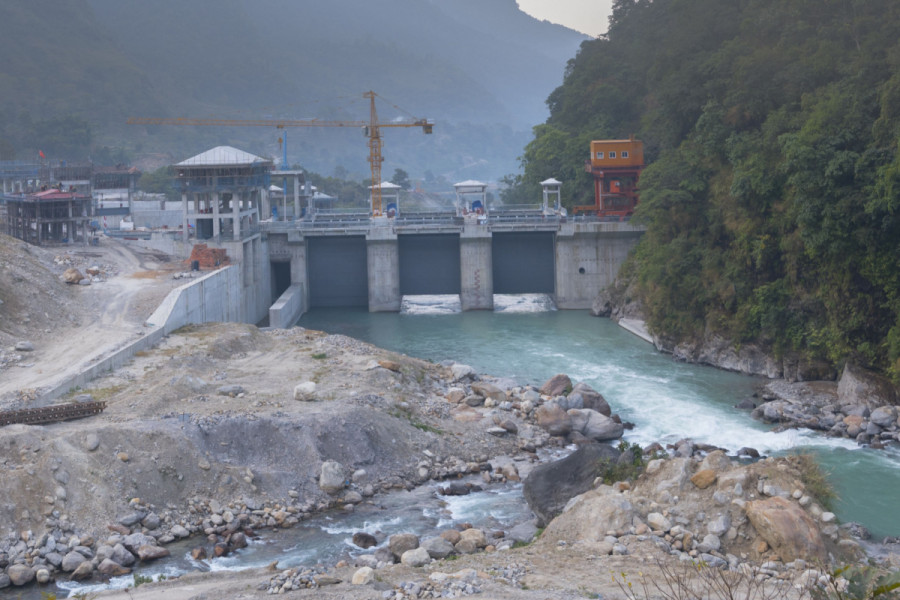Columns
Hydropower and South Asian integration
Nepal’s hydropower potential ranks among the highest globally in terms of per capita and unit of GDP.
Nischal Dhungel & Sisir Bhandari
Nepal’s hydropower potential for South Asia is now taking a pragmatic shape. Since the last decade, installed hydropower production has increased from 1,050 megawatts in 2012 to 2,700 megawatts by 2023. This will increase to 9,000 megawatts in the next 10 years as 235 hydropower plants are still under construction. With the national peak demand of 1,700 megawatts, a surplus energy of around 900 megawatts needs to be efficiently utilised. The rise of electricity production has led to a growth of energy-related industries. From 24 energy-related industries employing 5,424 people in 2006-07, the sector had swelled to 537 industries with 40,971 employees as of mid-March 2023. In addition, the energy sector creates indirect and induced opportunities in other sectors of the economy, such as transportation, manufacturing goods, irrigation and drinking water.
Against this background, energy can be an efficient tool and a backbone of Nepal’s economy, reducing the country’s dependency on fossil fuels. It is time to devise policies promoting domestic consumption, energy exports and investment in transmission infrastructures. Transitioning towards becoming a green energy powerhouse would economically, ecologically and politically benefit Nepal and South Asia.
Domestic consumption
According to the Nepal Electricity Authority (NEA), around 93 percent of its consumers are domestic and primarily use electricity for household appliances such as televisions, charging, heating and cooling. Consumers with higher electricity payloads, such as commercial hubs and industries, are limited to 0.27 percent and 0.69 percent, respectively. Nepal’s per capita electricity consumption is only around 325 kilowatt-hours, the lowest in South Asia, compared to India’s 1255 kWh, Bangladesh’s 497 kWh, Sri Lanka’s 631 kWh and Bhutan’s 5500 kWh. The low per capita consumption is primarily because of Nepal’s dependency on fossil fuels in the transportation, cooking and agricultural goods processing sectors.
On a positive note, electricity sales grew from 3 percent to 27 percent, with increased revenue from $19 million to $64.5 million in the last decade. This positive change reduced fossil fuel consumption; however, it is marginal to make a significant change. Nepal Oil Corporation data shows that the import of liquefied petroleum gas witnessed a steady decline of 19.2 million kg (1.3 million cylinders) during the initial eight months of 2022-23 compared to last year. This is a possible scenario of using electricity as a potential avenue to alleviate Nepal’s trade deficit, mainly through enhanced domestic consumption. The government of Nepal has set an ambitious target to increase per capita electricity consumption to 700 kWh by 2024 and transition from gasoline-powered vehicles to electric vehicles by 2031. It is time to implement policies focusing on efficient energy utilisation in household consumption, running manufacturing industries, transportation, irrigation support and water supply.
India is becoming the world’s economic powerhouse, followed by Bangladesh. These countries have a wide range of possible energy futures focused on reducing their dependency on coal and fossil fuels by quadrupling their production and consumption of renewable energy. Expanding economies with 1.57 billion population combined have the highest rate of urbanisation (an average of 2.6 percent combined) and rapid industrialisation. The energy demand of these countries will reach its highest by 2040. Most importantly, India aims to become a 100 percent electric-vehicle nation and meet 50 percent of its energy requirements from renewable energy by 2030. Similarly, Bangladesh aims to reduce carbon emissions by 22 percent before 2030. In this scenario, Nepal can serve as a liberator to salvage these countries’ demands and reduce carbon emissions with its enormous hydropower potential.
Nepal has already started trading electricity with India under Cross Border Electricity Trade and a tripartite agreement signed including Bangladesh. In 2022, Nepal exported 493 gigawatt-hours (GWh) of electricity to India. In the coming years, 50 megawatts of electricity will be sold to Bangladesh using the Baharampur-Bheramara cross-border transmission line. Nepal has recently sought a long-term inter-governmental agreement on power trading with India and Bangladesh, resulting in a historic 10,000 megawatt agreement with India. Given prompt execution, Nepal can soon become an energy champion for South Asia and contribute to a green economy. This energy trade can be expanded to Sri Lanka and Southeast Asia by broadening its transnational energy commerce beyond its existing dealings.
Policy and infrastructure
Nepal boasts significant hydropower potential, ranking among the highest globally in terms of per capita and unit of GDP. Unlocking this colossal resource and potential has been hampered by many constraints. They include institutional and policy complexities, inadequate infrastructure and investments, logistical hurdles in remote terrains, and concerns about project profitability. The NEA operates as a government-owned corporation, subject to political intervention, such as appointing political allies to crucial roles, interfering with its decision-making procedures, and potentially safeguarding political interests. This led to decisions based on political considerations regarding electricity price determination and power purchase agreements rather than technical or economic ones.
In addition, Nepal's primary energy export challenge is that India has refused to import electricity generated by hydropower projects involving Chinese and other investments. Private companies often complain about administrative bottlenecks in tax reimbursements, permit issuance and endorsements. However, the blame doesn’t lie solely with the government; the private sector also contributes to declining governance standards due to observed inadequacies and a lack of transparency. Consequently, reforming and restructuring Nepal’s electricity sector becomes an immediate imperative, serving as a crucial policy objective.
To navigate these obstacles, Nepal must pursue policy reforms that de-politicise domestic and foreign investments, incentivise public-private collaborations, prioritise transmission infrastructure, offer financial incentives and ensure environmental sustainability. Such a comprehensive strategy requires the concerted effort of both governmental/inter-governmental bodies and private sector stakeholders. The involvement of development partners, such as the World Bank’s support through Green, Resilient and Inclusive Development, alongside climate financing and the United States-Nepal Millennium Challenge Cooperation compact for electricity transmission and road infrastructure, is timely evident. As export-oriented hydropower projects would demand yearly incremental financing from $0.5 billion to $1.0 billion, the support of international development partners will be crucial in achieving energy goals.
Electricity can be a valuable instrument in mitigating Nepal’s trade deficit by bolstering domestic consumption, luring infrastructure investments, and fostering regional integration by exporting power. The regional collaboration offers the opportunity to diversify energy needs, requiring unwavering commitment, support, and leadership from Nepal, India, Bangladesh and international partners.




 6.73°C Kathmandu
6.73°C Kathmandu
















